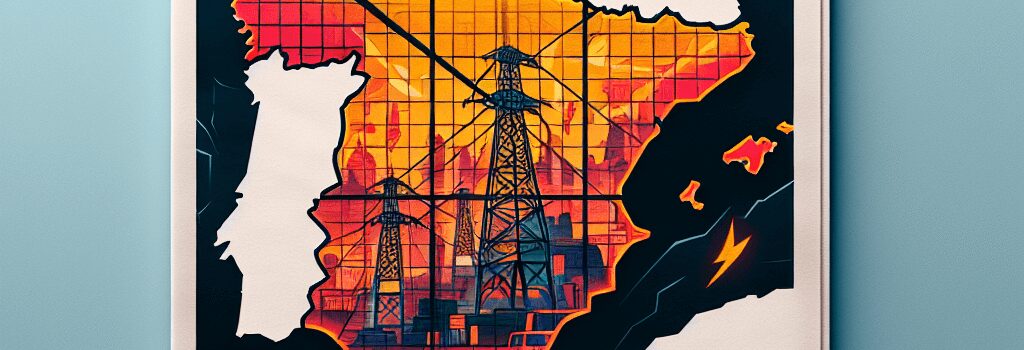Spain’s Major Challenges After Iberian Grid Collapse

Introduction: Understanding the Black Start Imperative
On April 28, 2025, Spain and Portugal experienced a massive Iberian Peninsula blackout affecting over 20 million people. Grid operators have entered the critical “black start” phase—re-energizing a dead network by bootstrapping generation from a handful of self-starting plants. Unlike a normal outage restart, a black start must proceed in precise stages to avoid system collapse, matching generation and load while protecting equipment from frequency excursions.
Technical Anatomy of a Black Start
A black start sequence begins with black-start-capable plants that possess on-site prime movers—typically diesel generators sized 500 kW–5 MW or small hydro turbines—to power their own auxiliary loads. These auxiliaries include:
- High‐capacity feed pumps and control valves in steam turbines
- Coal pulverizers and conveyor motors
- SCADA (Supervisory Control And Data Acquisition) terminals and protective relays
Once these plants supply around 20–50 MW each, operators close high-voltage circuit breakers to form an isolated restart island. Within that island, precision synchronization equipment ensures all generators spin at the grid standard of 50.00 Hz ±0.02 Hz. Any frequency drift outside ±0.1 Hz can trigger under-frequency load shedding or generator trip protections, pushing the system back to zero.
Primary Black-Start-Capable Facilities
- Hydropower Stations: With capacities of 50 MW–300 MW, facilities like Aldeadávila (Turbine: Francis, 220 MW) require only excitation power to begin generation.
- Combined Cycle Gas Turbines (CCGT): Equipped with auxiliary diesel gens (1–2 MW), plants such as Ciclo Combinado de Castellón can black start within 30 minutes.
- Diesel Peakers: Mobile units rated 5–20 MW serve as mobile black start sources but are limited by on-site fuel and emissions constraints.
Grid Synchronization and Frequency Control
Each generator’s rotor inertia resists rapid frequency changes. During restart, operators use Fast-Acting Frequency Containment Reserves (FCR-N) and Dynamic Voltage Restorers (DVRs) to dampen oscillations. According to Dr. María Sánchez, Professor of Power Systems at Universidad Politécnica de Madrid, “The key is a Phasor Measurement Unit (PMU) network that provides sub-millisecond synchrophasor data, enabling real-time control of rotor angle stability across hundreds of kilometers.”
Leveraging Cross-Border Interconnections
Spain and Portugal’s grid interties to France (400 kV, 2 GW capacity) and Morocco (225 kV, 300 MW) can import black-start energy. However, operators must isolate demand side breakers and ramp intertie imports gradually—typically 100 MW every 10 minutes—to avoid back-feeding faults. Recent tests by Red Eléctrica de España validated a Phase-Shifting Transformer protocol that allows controlled power injection under no-load conditions.
The Role of Renewables in Black Start Operations
Hydropower currently supplies ~10% of Spanish demand and ~25% in Portugal, making it a reliable black-start backbone. Wind farms (averaging 2 MW per unit) could contribute via Grid-Forming Inverters if retrofitted. On April 29, REE engineers successfully tested a PPA-connected wind park in Galicia in “island mode,” exporting 15 MW to a restart island with less than 0.05 Hz deviation.
Solar PV’s direct current output requires Voltage Source Converters (VSCs) capable of black start mode. While most Spanish solar parks lack this firmware, recent EU grants (€150 million under the Recovery and Resilience Facility) aim to upgrade inverters to support synthetic inertia.
Advancements in Battery Storage and Microgrids
Grid-scale batteries (Li-ion, 100–200 MWh installations) can deliver instantaneous power for frequency regulation and black start. As of 2025, only 0.5 GW of storage exists on the Iberian grid, but projects like NextEra’s Castilla-La Mancha 150 MW/300 MWh battery plant are slated for Q4 2026 commissioning. These systems leverage bidirectional inverters to transition from island mode to grid paralleling, smoothing voltage transients during load pickup.
Innovative microgrids—such as the Hybrid Renewable Microgrid at the University of Seville—combine PV, wind, battery, and diesel gensets under an IEC 61850 control architecture, offering a blueprint for modular black-start islands in remote regions.
Regulatory and Policy Landscape
The European Network of Transmission System Operators for Electricity (ENTSO-E) mandates black start capabilities in its Network Code on System Operation (NC SOP). Spain’s National Energy and Climate Plan allocates €3 billion to strengthen cross-border ties and deploy FACTS (Flexible AC Transmission Systems) devices. Meanwhile, Portugal’s 2025 Energy Strategy targets 5 GW of grid-scale storage by 2030, incentivizing private investment through long-term capacity contracts.
Conclusion: The Path to Resilient Grid Restoration
Spain and Portugal’s ongoing black start effort is a high-stakes technical and logistical endeavor. It demands the coordinated operation of legacy thermal plants, hydropower, nascent battery assets, and interconnector imports. Experts agree that bolstering grid resilience requires investments in advanced inverters, real-time monitoring (PMUs), and flexible reserves. As operators sequentially energize generation islands and raise frequency from zero to 50 Hz, they race against time—and demand—to restore power safely. If successful, this black start will stand as one of the largest—and most complex—system restorations in European history.